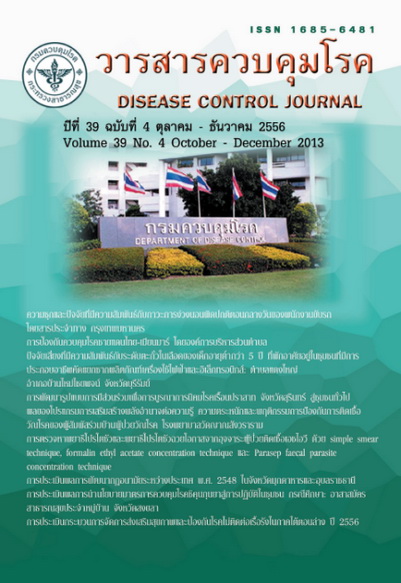Comparative study of simple smear, formalin ethyl acetate concentration and Parasep® faecal parasite concentration technique for identification of the parasite and opportunistic protozoa in stool specimen from HIV infected patients
DOI:
https://doi.org/10.14456/dcj.2013.6Keywords:
Protozoa, Opportunistic Protozoa, Stool, HIVAbstract
This Study aimed to compare the diagnostic yields for parasites and opportunistic parasites in stool samples using three methods: simple smear, formalin ethyl acetate concentration and Parasep® faecal parasite concentration. Two hundred stool samples of HIV-infected patients were collected for laboratory investigation at Bamrasnaradura Infectious Diseases Institute. The stool samples were observed under the light microscope by 3 methods using (1) direct wet smear, (2) iodine preparations and (3) modified Ziehl- Neelsen stain. The diagnostic yield for parasites and opportunistic parasites using Parasep® was higher than that of simple smear, formalin ethyl acetate concentration with the percentage of 10.5, 8.0 and 4.0, respec¬tively. The diagnostic yield for opportunistic parasites by modified Ziehl-Neelsen stain. The Parasep® and Simple smearwere higher than that of formalin ethyl acetate concentration with 10.0, 10.5 and 7.0, respec-tively. This study suggests that the Parasep® together with the standard simple smear can potentially enhance the laboratory reports for diagnosing protozoas and opportunistic parasites. The result indicates that Parasep® can be used to improve the diagnostic yields for protozoas and opportunistic parasites in stool samples.
Downloads
References
2. Wiwanitkit V. Intestinal parasitic infections in Thai HIV-infected patients with different im¬munity status. BMC Gastroenterology 2001; 1:3.
3. Babatunde SK, Salami AK, Fabiyi JP, Agbede oo, Desalu oo. Prevalence of intestinal para¬sitic infestation in HIV seropositive and serone¬gative patients in Ilorin, Nigeria. Ann Afr Med 2010;9:123-8.
4. Levine JA, Estevez EG. Method for concentra¬tion of parasites from small amounts of feces. J Clin Microbiol 1983;18:786-8.
5. Feleke M, Yeshambel B, Moges T, Yenew K, Andragachew M, Afework K, et al. Comparison of formol-acetone concentration method with that of the direct iodine preparation and formol-ether concentration methods for examination of stool parasites. Ethiop J Health Dev 2010;24:148- 51.
6. Kettelhut M, Moody A, Edwards H, Chiodini PL. Evaluation of Parasep® faecal parasite con¬centrator [Internet], [cited 2003 March 07]. Available at: http://www.diasys.com/PDF/ PARO 2 9 - HTD_Evaluation_Mkettelhut_ AMoody.pdf.
7. Moody A H, Sitara R, Mercedes ร. Evaluation of Parasep? SF, Ether and Ethyl Acetate Free Faecal Concentrators. [Internet], [cited 2011 April 05].Available at http://www.diasys.com/ PDF/ Evaluation_Document_ParasepSF.pdf.
8. Derrick B, Blundell N, Hart CA. The develop¬ment and performance of a simple, sensitive method for the detection of Cryptosporidium Oo¬cysts in faeces. Journal of Hygiene 1984;93: 317-23.
9. Kaplan JE, Benson c, Holmes KH, Brooks JT, Pau A, Masur H. Guidelines for prevention and treatment of opportunistic infections in HIV-in¬fected adults and adolescents: recommendations from CDC, the National Institutes of Health, and the HIV Medicine Association of the Infectious Diseases Society of America. MMWR 2009; 58:1-207.
10. Nelson M, Dockrell D, Edwards ร. British HIV Association (BHIVA) 'Guidelines for the treat¬ment of opportunistic infection in HIV-positive individuals 2010' (In consultation period). [Internet], [cited 2010 June 15]. Available at http://www.liv.ac.uk/hiv/2010_ BHIVA_OI- GuidelineConsultationVersion.pdf.
Downloads
Published
How to Cite
Issue
Section
License
Articles published in the Disease Control Journal are considered as academic work, research or analysis of the personal opinion of the authors, not the opinion of the Thailand Department of Disease Control or editorial team. The authors must be responsible for their articles.






